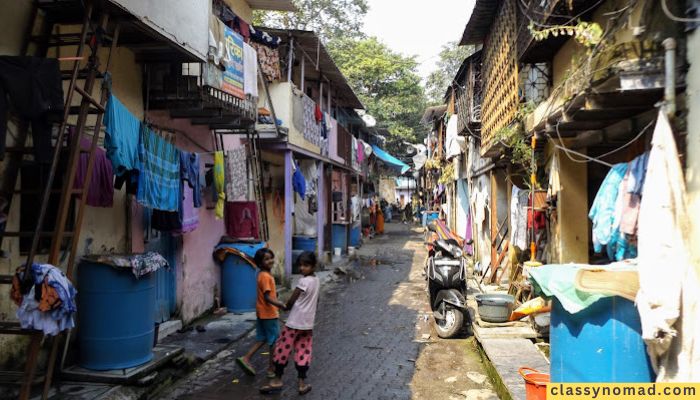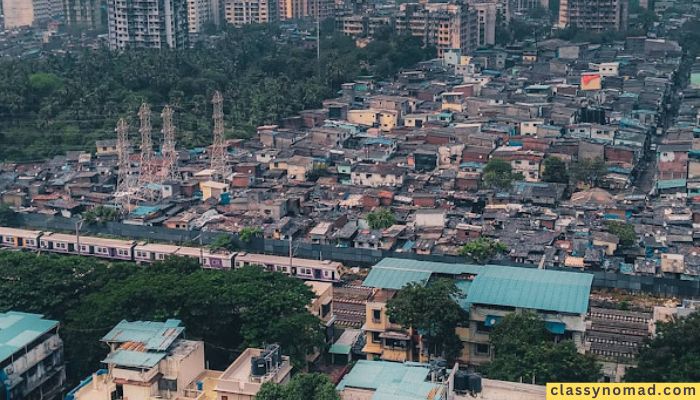Discover fascinating insights and lesser-known truths about Dharavi Slum with our comprehensive guide on the facts about Dharavi Slum.
Dharavi Slum, the beating heart of Mumbai, is one of the most intriguing and diverse neighborhoods in the city.
Did you know that Dharavi is home to over a million people and covers an area of just over 2.1 square kilometers? Yes, you read that right. It’s one of the most densely populated areas in the world, and yet it’s a hub of economic activity and creativity.
If you’re interested in learning more about Dharavi Slum and its fascinating history and culture, then this post is for you. In this article, we’ll be exploring some interesting and lesser-known facts about Dharavi Slum.
Suggested –
- Best Dharavi Slum Tours in Mumbai
- Best Elephanta Caves Tours from Mumbai
- Best Bollywood Tours in Mumbai
- Best Food Tours in Mumbai
Interesting Facts About Dharavi Slum
1. Origins of Dharavi Slum

Dharavi was originally a fishing village, inhabited by the Koli community, one of the oldest indigenous groups in Mumbai. It gradually transformed into a slum over time as migrants from other parts of India moved to the area in search of work and affordable housing.
2. Historical events that led to the Growth of the Slum
The growth of Dharavi as a slum can be traced back to various historical events, including the development of Mumbai as a port city, the migration of people from rural areas in search of work, and the closure of textile mills in the city in the 1980s.
3. Demographics and Population
Dharavi is home to over 1 million people, making it one of the most densely populated areas in the world. The population is diverse, with people from different religious, ethnic, and linguistic backgrounds living in the slum.
4. Economic Activities in Dharavi
Dharavi is known for its bustling informal economy, with numerous small-scale industries operating in the slum. These include leather goods, pottery, textiles, and recycling. The area is also home to several retail markets.
5. Living Conditions in Dharavi

Living conditions in Dharavi can be challenging due to overcrowding, lack of basic amenities, and poor sanitation. Many residents live in small shanties or cramped apartments with limited access to clean water, electricity, or proper waste disposal facilities.
6. Education and Healthcare
Dharavi has a few public schools and healthcare facilities, but access to quality education and healthcare can be limited for many residents. NGOs and community-based organizations play a significant role in providing basic education and healthcare services to the residents.
7. Community and Social Life
Despite the challenging living conditions, Dharavi has a strong sense of community and social life. Residents often come together for community events, festivals, and activities. The area is also home to several non-profit organizations that work to improve the quality of life for the residents.
8. Tourism in Dharavi
In recent years, Dharavi has become a popular destination for tourists looking to experience the culture and way of life in the slum. While tourism can provide economic benefits to the community, it can also have negative impacts if not done responsibly. Many responsible tour operators are now working with the community to ensure that tourism is sustainable and benefits the residents.
9. Innovations and Sustainability
Residents of Dharavi have developed innovative solutions to address the challenges of living in the slum. For example, many residents have developed their own recycling systems to reduce waste and generate income. NGOs and community-based organizations are also working on sustainable development initiatives in the area.
10. Film Industry in Dharavi
Dharavi has also become a popular location for the Indian film industry. Many Bollywood movies have been filmed in the slum, including the critically acclaimed movie “Slumdog Millionaire.” The film’s success brought international attention to Dharavi and sparked discussions about poverty and inequality in India.
11. Challenges and Opportunities for Development
Dharavi faces several challenges in terms of development, including inadequate infrastructure, poor living conditions, and limited access to basic services. However, the area also presents significant opportunities for sustainable development, given its strategic location and diverse economic activities.
12. Art and Culture in Dharavi
Dharavi is also known for its vibrant art and culture scene. The area is home to several artists and musicians who draw inspiration from their surroundings. The community’s resilience and creativity have also been reflected in various art and cultural projects in the slum.
13. Government and NGO Initiatives
Both the government and NGOs have been working to improve living conditions in Dharavi. The government has launched several redevelopment projects aimed at providing better housing and infrastructure for the residents. NGOs and community-based organizations have also been working to provide education, healthcare, and livelihood opportunities to the residents.
14. Importance of Community Participation
The participation of the community is crucial in any development initiatives in Dharavi. Community-based organizations and NGOs work closely with the residents to ensure that their voices are heard, and their needs are addressed. Such initiatives have been successful in improving the quality of life for the residents.
15. Recycling and Waste Management in Dharavi
Dharavi is also known for its recycling and waste management practices. The slum is home to several small-scale industries that recycle waste materials, such as plastic and paper, to produce new products. The recycling industry provides livelihood opportunities for the residents and also helps to reduce the amount of waste sent to landfills.
16. Religious Diversity in Dharavi
Dharavi is a melting pot of different religions and cultures. The area is home to several religious communities, including Hindus, Muslims, Christians, and Buddhists. The community celebrates festivals and events together, showcasing the unity and diversity of the neighborhood.
17. The Impact of COVID-19 on Dharavi
The COVID-19 pandemic had a significant impact on the residents of Dharavi, who were particularly vulnerable to the virus due to their living conditions. The government and non-governmental organizations launched several initiatives to provide relief and assistance to the residents during those challenging times.
18. Education and Learning Opportunities in Dharavi
Several organizations are working to provide education and learning opportunities for the children and youth in Dharavi. These initiatives aim to break the cycle of poverty and provide the residents with the skills and knowledge to improve their lives and livelihoods.
19. Sports and Recreation in Dharavi
Sports and recreation are essential for the physical and mental well-being of the residents of Dharavi. Several organizations are working to provide sports and recreation facilities in the slum, including cricket, football, and other games.
Conclusion – Interesting Facts about Dharavi Slum
Dharavi Slum is a unique and fascinating place that offers an eye-opening experience to visitors. The facts about Dharavi Slum have shown that it is not just a place of poverty but also a place of resilience, innovation, and community spirit.
FAQs – Interesting Facts about Dharavi Slum
1. How big is Dharavi Slum?
Dharavi Slum covers an area of approximately 2.1 square kilometers, with a population estimated at around one million people.
2. What is the main source of income in Dharavi?
The main source of income in Dharavi is the informal sector, which includes small-scale industries such as recycling, pottery, and leatherwork.
3. Is it safe to visit Dharavi Slum?
Yes, it is safe to visit Dharavi Slum, as long as you take the necessary precautions and follow the guidelines of your tour guide.

